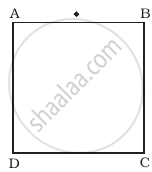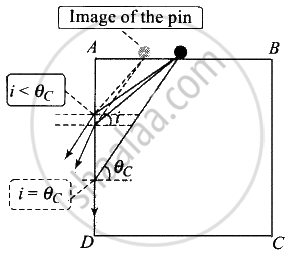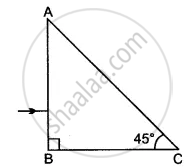Advertisements
Advertisements
प्रश्न
A rectangular block of glass ABCD has a refractive index 1.6. A pin is placed midway on the face AB (Figure). When observed from the face AD, the pin shall ______.

- appear to be near A.
- appear to be near D.
- appear to be at the centre of AD.
- not be seen at all.
पर्याय
a and c
a and d
b and d
c and d
उत्तर
a and d
Explanation:
As long as angle of incidence on AD of the ray emanating from the pin is less than the critical angle, the pin shall appear to be near A.

When angle of incidence on AD of the ray emanating from pins is greater than the critical angle, the light suffers from total internal reflection and cannot be seen through AD.
APPEARS IN
संबंधित प्रश्न
State two conditions necessary for total internal reflection to occur.
In the following figure, show two rays A and B travelling from water to air. If the critical angle for water- air surface is 48°, complete the ray diagram showing the refracted rays for each. State conditions when the ray will suffer total internal reflection.

State two advantages of using a right-angle prism as a reflector, rather than a plane mirror.
A ray of light passes through a right-angled prism as shown in the figure. State the angles of incidence at the faces AC and BC.

Choose the correct option.
Consider the following phenomena/ applications: P) Mirage, Q) rainbow, R) Optical fibre and S) glittering of a diamond. Total internal reflection is involved in
Answer the following question.
Define the critical angle of incidence and obtain an expression for it.
Solve Numerical example.
A monochromatic ray of light is incident at 37° on an equilateral prism of refractive index 3/2. Determine angle of emergence and angle of deviation. If angle of prism is adjustable, what should its value be for emergent rays to be just possible for the same angle of incidence?
For total internal reflection to take place, the angle of inddence i and the refractive index µ of the medium must satisfy the inequality ____________.
Optical fibre communication uses the principle of ______.
